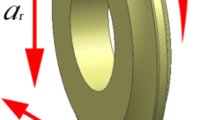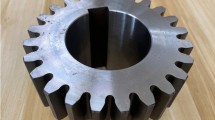Abstract
The surface residual stress significantly influences the performance of gears. The residual stresses of different grinding positions on the gear surface are different. Focusing on the gear profile grinding process, the residual stress distribution of gear tooth flank is investigated. To measure the residual stress of gear tooth accurately, a specific measurement method, including adjustment angle calculation model and alignment fixture, is carried out. The measured results with the proposed method are much better, and differences of residual stresses among measured positions are discussed. Then, considering the variation of chip geometry, a gear grinding model is proposed to analyze the residual stress distribution of gear tooth flank. The changing trend of the section area of the cutting chip calculated by the proposed grinding model matches the changing trend of measured results of the residual stress distribution. Finally, experiments are conducted, and the grinding model is verified from the perspective of cutting parameters.





















Similar content being viewed by others
Availability of data and material
The datasets used during the current study are available from the corresponding author on reasonable request.
Code availability
The code used during the current study is available from the corresponding author on reasonable request.
References
Lin J, Parker RG (1999) Analytical characterization of the unique properties of planetary gear free vibration. J Vib Acoust 121(3):316–321
Pala Z, Ganev N (2008) The impact of various cooling environments on the distribution of macroscopic residual stresses in near-surface layers of ground steels. Mater Sci Eng A 497(1-2):200–205
Hein M, Tobie T, Stahl K (2017) Parameter study on the calculated risk of tooth flank fracture of case hardened gears. Journal of Advanced Mechanical Design, Systems, and Manufacturing 11(6):1–12
He H, Liu H, Zhu C, Tang J (2019) Study on the gear fatigue behavior considering the effect of residual stress based on the continuum damage approach. Eng Fail Anal 104:531–544
Wang W, Liu H, Zhu C, Sun Z (2019) Evaluation of contact fatigue life of a wind turbine carburized gear considering gradients of mechanical properties. International Journal of Damage Mechanics 28(8):1170–1190
Brinksmeier E, Lübben T, Fritsching U, Cui C, Rentsch R, Sölter J (2011) Distortion minimization of disks for gear manufacture. Int J Mach Tools Manuf 51(4):331–338
Rego R, Löpenhaus C, Gomes J, Klocke F (2018) Residual stress interaction on gear manufacturing. J Mater Process Technol 252:249–258
Zhou R, Yang W (2019) Analytical modeling of machining-induced residual stresses in milling of complex surface. Int J Adv Manuf Technol 105(1-4):565–577
Ma Y, Feng P, Zhang J, Wu Z, Yu D (2016) Prediction of surface residual stress after end milling based on cutting force and temperature. J Mater Process Technol 235:41–48
Wang Y, Chu X, Huang Y, Su G, Liu D (2019) Surface residual stress distribution for face gear under grinding with a long-radius disk wheel. Int J Mech Sci 159:260–266
Wang Y, Zhang W, Liu Y (2018) Analysis model for surface residual stress distribution of spiral bevel gear by generating grinding. Mech Mach Theory 130:477–490
Manns T, Scholtes B (2013) Diffraction residual stress analysis in technical components — Status and prospects. Thin Solid Films 530:53–61
Savaria V, Monajati H, Bridier F, Bocher P (2015) Measurement and correction of residual stress gradients in aeronautical gears after various induction surface hardening treatments. J Mater Process Technol 220:113–123
Rodman D, Krause KC, Nürnberger F, Bach F-W, Gerdes L, Breidenstein B (2012) Investigation of the surface residual stresses inspray cooled induction hardened gearwheels. Int J Mater Res 103(1):73–79
El-Axir MH (2002) A method of modeling residual stress distribution in turning fordifferent materials. Int J Mach Tools Manuf 42:1055–1063
Nemetz AW, Daves W, Klünsner T, Ecker W, Teppernegg T, Czettl C, Krajinović I (2018) FE temperature- and residual stress prediction in milling inserts and correlation with experimentally observed damage mechanisms. J Mater Process Technol 256:98–108
Sun T, Roy MJ, Strong D, Simpson C, Withers PJ, Prangnell PB (2019) Weld zone and residual stress development in AA7050 stationary shoulder friction stir T-joint weld. J Mater Process Technol 263:256–265
Ding W, Zhang L, Li Z, Zhu Y, Su H, Xu J (2016) Review on grinding-induced residual stresses in metallic materials. Int J Adv Manuf Technol 88(9-12):2939–2968
Rasim M, Mattfeld P, Klocke F (2015) Analysis of the grain shape influence on the chip formation in grinding. J Mater Process Technol 226:60–68
Litvin FL, Peng A, Wang A (1999) Limitation of gear tooth surfaces by envelopes to contactlines and edge of regression. Mech Mach Theory 34:889–902
Prime MB (2001) Cross-sectional mapping of residual stresses by measuring the surfavce contour after a cut. J Eng Mater Technol 123:162–168
Butler-Smith P, Axinte D, Daine M, Kong MC (2014) Mechanisms of surface response to overlapped abrasive grits of controlled shapes and positions: an analysis of ductile and brittle materials. CIRP Ann 63(1):321–324
Chang H, Wang JJJ (2008) A stochastic grinding force model considering random grit distribution. Int J Mach Tools Manuf 48(12-13):1335–1344
Ben Fathallah B, Ben Fredj N, Sidhom H, Braham C, Ichida Y (2009) Effects of abrasive type cooling mode and peripheral grinding wheel speed on the AISI D2 steel ground surface integrity. Int J Mach Tools Manuf 49(3-4):261–272
Wan M, Ye X, Yang Y, Zhang W (2017) Theoretical prediction of machining-induced residual stresses in three-dimensional oblique milling processes. Int J Mech Sci 133:426–437
Ling H, Yang C, Feng S,Lu H (2020) Predictive model of grinding residual stress for linear guideway considering straightening history. International Journal of Mechanical Sciences. 176
Liang SY, Su JC (2007) Residual stress modeling in orthogonal machining. CIRP Ann 56(1):65–68
Wang SB, Geng L, Zhang YF, Liu K, Ng TE (2015) Cutting force prediction for five-axis ball-end milling considering cutter vibrations and run-out. Int J Mech Sci 96-97:206–215
Hou ZB, Komanduri R (2003) On the mechanics of the grinding process – Part I. Stochastic nature of the grinding process. Int J Mach Tools Manuf 43(15):1579–1593
Jiang J, Ge P, Hong J (2012) Study on micro-interacting mechanism modeling in grinding process and ground surface roughness prediction. Int J Adv Manuf Technol 67(5-8):1035–1052
Wang L, Tian X, Liu Q, Li Y, Tang X, Yang L (2017) Experimental study and theoretical analysis of the form grinding of gears using new type micro-crystal corundum grinding wheels. Int J Adv Manuf Technol 92(5-8):1659–1669
Funding
This work was supported by the Key Project of National Natural Science Foundation of China (Grant no. 51635003); the National Natural Science Foundation of China (Grant no. 51905057); the Natural Science Foundation Project of Chongqing, Chongqing Science and Technology Commission (Grant No.cstc2019jcyj-msxmX0050); and the State Key Laboratory for Manufacturing Systems Engineering for Xi’an Jiaotong University (sklms2020016).
Author information
Authors and Affiliations
Contributions
Yuliang Xiao: Methodology, formal analysis, writing original draft, visualization, validation.
Shilong Wang*: Conceptualization, supervision, funding acquisition, project administration.
Chi Ma: Methodology, writing—review and editing, funding acquisition.
Sibao Wang: Investigation, writing—review and editing
Lili Yi: Experimental setup, data acquisition, data curation.
Changjiu Xia: Data curation, formal analysis, writing—review and editing.
Jianpeng Dong: Software, writing—review and editing.
All authors of this paper have directly participated in planning, execution, and analysis of this research.
Corresponding author
Ethics declarations
Conflict of interest
The authors declare no competing interests.
Additional information
Publisher’s note
Springer Nature remains neutral with regard to jurisdictional claims in published maps and institutional affiliations.
Rights and permissions
About this article
Cite this article
Xiao, Y., Wang, S., Ma, C. et al. Measurement and modeling methods of grinding-induced residual stress distribution of gear tooth flank. Int J Adv Manuf Technol 115, 3933–3944 (2021). https://doi.org/10.1007/s00170-021-07392-w
Received:
Accepted:
Published:
Issue Date:
DOI: https://doi.org/10.1007/s00170-021-07392-w




